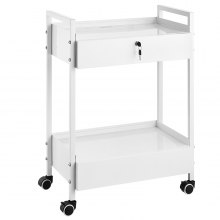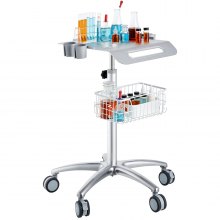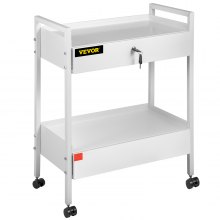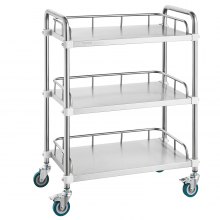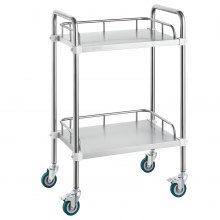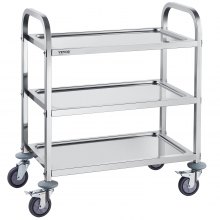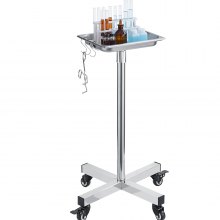VEVOR Lab Carts: The Path to a Well-Organized and Efficient Laboratory
A lab cart is a crucial piece of lab equipment that makes transferring and organizing different lab equipment and supplies easier. Lab carts are essential for laboratories because they streamline the transportation of materials and instruments, foster organization, and increase productivity.
Every laboratory should have quality lab carts. At VEVOR, we provide high-quality, long-lasting lab carts. VEVOR laboratory carts’ storage and mobility options substantially aid in streamlining workflow and improving research procedures.
How To Choose The Right Lab Cart?
A mobile workstation called a clinical lab cart makes it simple for laboratory personnel to move about the lab. For organizing equipment and supplies, clinical lab carts frequently have several kinds of shelves, drawers, and sections.
Some clinical lab carts have an integrated sink for simple cleanup and an electrical strip to power equipment. While laboratory carts have several advantages, choosing one compatible with your lab's requirements is crucial. You can choose the best lab carts by considering these factors.
· Load capacity: Analyze the load that the cart will transport. Choose a lab cart with a load capacity to securely hold the heaviest supplies or instruments you intend to move.
· Mobility considerations: Take your lab's mobility needs into account. Select a lab cart with wheels or casters if you intend to move it regularly. To avoid mishaps, make sure they are sturdy and lockable.
· Maintenance and Resilience: Pick a stainless steel lab cart that can handle the rigors of your lab setting by being composed of sturdy materials. Think about things like rusting, chemical, and wear-and-tear resistance. Surfaces that are simple to clean are a benefit.
· Handle Design: Take into account the handle design to make the cart easier to push or pull. The pressure on lab workers can be lessened with ergonomic handles, particularly if the cart will be transported frequently.
· Budget: While having a high-quality lab equipment cart is important, ensuring it fits within the lab's budget is important. Modern laboratories run smoothly in large part because of lab carts. They link various lab areas, ensuring everything is moved quickly, safely, and effectively.
Lab Cart Accessories
Accessories for laboratory carts are extra parts or features that can improve the usability and convenience of these carts. These items can accommodate the different lab requirements and tasks. Here are a few typical lab cart accessories:
· Baskets & Bins: Thanks to attachable bins and baskets, small objects, consumables, or samples can be stored in additional space. They aid with keeping things accessible and organized.
· Storage Drawers: Lab carts can be equipped with drawer units to store tiny tools, instruments, or documents safely. They facilitate better organization and clutter prevention.
· Cord and Cable Management: Electrical and data cables can be kept neatly organized and minimize tripping hazards with the help of clips, clamps, or brackets made specifically to organize cords and cables.
· Holders and Trays: For certain lab tools or equipment, such as pipettes or microscopes, trays and holders are available to enable stable transit placement.
· Lockable Compartments and Drawers: Lockable shelves and compartments give an extra layer of security for laboratories using delicate or expensive equipment or samples.
Benefits of Lab Carts
The value of a lab cart goes beyond its fundamental role as a means of item transportation. These carts ensure that sensitive equipment, important samples, and required reagents are properly transported while easily accessible, lowering risks and streamlining operations. The crucial function of laboratory carts is effectively explained by the points below:
Efficient Use of Space
Laboratory carts make efficient use of available space by offering vertical storage. Numerous trolleys have numerous shelves, which let labs organize store supplies, tools, and samples without taking up much room on the floor.
Flexibility and Mobility
Lab carts with wheels make it easy for tools, equipment, and specimens to move throughout the laboratory. This mobility is especially useful in multidisciplinary labs where it is customary to exchange equipment. Scientists can easily wheel the required equipment to their stations rather than traveling to and from between workstations.
Enhanced Effectiveness and Safety
Laboratory carts boost productivity by shortening the time needed for tasks. They enable quick access and resource mobility to speed up workflow. Laboratory carts reduce mishaps by offering safe storage for delicate or dangerous substances.
Enhancing Organization
A lab that is structured well produces more. The use of lab carts for particular tasks or experiments is possible. This expedites procedures and lowers the possibility of errors brought on by missing or items that were lost.
Versatility
Laboratory carts are available in a variety of shapes and sizes. Some are built with power sources for electronics, while others are made to transport and store precious glassware safely. With so many choices, laboratories can properly select trolleys that meet their specific needs.
Why Purchase VEVOR Lab Carts?
Investing in VEVOR lab carts has several attractive benefits. Excellent quality lab carts that satisfy the demanding requirements of laboratory environments are a specialty of VEVOR. Their laboratory carts are built to last and are resistant to corrosion and harsh chemicals, thanks to the sturdy materials used in their construction.
VEVOR lab carts are available in various layouts to meet laboratory demands, including equipment transport and storage. Thanks to smart design, they frequently have movable shelves, comfortable handles, and safe locking systems for safety.
FAQs About Lab Carts
Q: What materials are lab carts typically made from, and which is best for my lab?
304-grade stainless steel is the most common material for making laboratory carts. Good heat resistance, corrosion resistance, and material strength are all characteristics of stainless steel 304.
Q: What is the weight capacity of a typical lab cart?
Based on its construction and intended purpose, the weight capacity of a conventional lab cart varies, although it often runs from 200 to 500 pounds.
Q: Can lab carts be used in cleanroom environments?
Yes, lab carts are suitable for use in cleanroom settings as long as they adhere to certain requirements, such as being manufactured of hygienic-compatible materials and having contamination control features.




























































